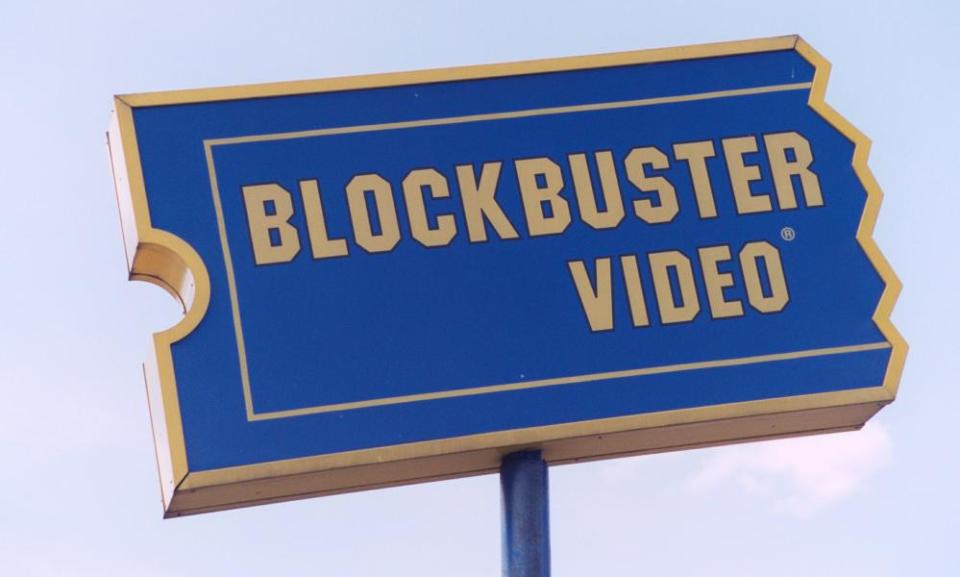Is Blockbuster video about to make a comeback?

A few days ago, something strange happened in a forgotten corner of the internet. The website for Blockbuster, the long-dormant obsolete VHS rental chain, twitched back into life. It doesn’t always work – there’s more than a fighting chance that you’ll be taken to an error page – but if the winds are blowing in just the right direction, you’ll see a brand new landing page, accompanied by the text “We are working on rewinding your movie”. To all intents and purposes, it seems to be a sign that the universe isn’t quite done with Blockbuster yet.
Related: Fake Blockbuster in Los Angeles rewinds to a pre-Netflix era
Which is fairly preposterous, of course, because the universe is absolutely done with Blockbuster and has been for some time. A world-conquering behemoth in its day, a juggernaut that crushed the necks of smaller independent video stores, Blockbuster took over the world in the 90s and early 2000s. But its glory was short-lived. Netflix came, first in its DVD-by-post guise and then as an unstoppable streamer, and custom disintegrated overnight. If Blockbuster exists in any form now it’s as a punchline, a reference to anything too bloated and arrogant to notice the looming shadow of imminent catastrophe. Which raises the question: what is this new website, exactly?
We can start by ruling out the obvious. There were similar stirrings of excitement last year when Blockbuster’s parent company Dish filed a trademark application for an updated logo, but that simply turned out to be a marketing tie-in for the Netflix sitcom Blockbuster – about the hapless staff of the last working Blockbuster branch – that itself was cancelled after just 10 episodes on the basis of it not being very good.
The same thing happened earlier last year, too, when Blockbuster filed another trademark application for a cryptocurrency and NFT marketplace. Again, this was another terrible idea. Again, it came to nothing. Hopefully by now, Blockbuster understands that it has nothing to gain from simply cashing in on its name as a hit of cheap nostalgia. No, if it is coming back at all, it has to be for the right reason. It has to be for a full-blown return.

If you understand the history of Blockbuster, you will understand its unquenchable thirst for glory. It’s almost impossible to overstate just how ubiquitous the chain was at the turn of the millennium. Founded by a wily businessman by the name of David Cook, whose intense love of databases meant that he could analyse demographics and tailor the stock of individual branches accordingly, Blockbuster started opening new locations at a terrifying clip. Look at FleetLogging’s timeline of new Blockbuster branches in the US alone. In November 1986 there were just nine branches. A year later, there were 99. A year after that, 351, then 882. By January 2005, 5,734 Blockbuster branches were in operation in the States, with thousands more worldwide.
And little wonder. Not only did branches of Blockbuster have a bigger range of videos to rent than their small-time counterparts, but the stores were cleaner and more family safe – no porn section here – and the branding was as inescapable as Coca-Cola. For a while, it looked as if Blockbuster was going to be a permanent feature of home entertainment.
It could have been, too, had it not been for the almighty hubris and terrible decision-making skills of its board. In 1997, Warner Bros approached Blockbuster with an exclusive DVD rental deal that would have split revenue 60-40 in favour of the studio. Blockbuster rejected it, and the studio retaliated by dropping its DVD retail prices to undermine the rental industry. And then in 2000, Blockbuster made two even more fatal decisions. First, Blockbuster turned down the opportunity to purchase the then-fledgling Netflix. Second, it chose instead to partner with Enron. Within a year, Enron filed for bankruptcy. Within five years, Netflix was shipping out a million DVDs every day. Suddenly, Blockbuster was yesterday’s news.
If you kept watching the FleetLogging timeline, you’ll see that the subsequent contraction was just as spectacular as its growth. By 2012 there were just 1,503 Blockbuster branches in operation. A year later, 787. A year later, just 54. Just one branch of Blockbuster is currently in operation globally, in Bend, Oregon. It now primarily exists as a tourist attraction, the same way that people travel to visit the ancient ruins of Pompeii.
Could this be time for a comeback? The warm advance notices for the upcoming Blackberry movie is a sign that there is a hunger for stories about giants swept aside by progress. Might there be a new Blockbuster movie on the horizon? Something big and retrospective, that finally does justice to the cultural void it left behind? Or maybe something bigger is brewing. Look at the current state of the streamers, a thin spread of near-identical services all hurling money away in a desperate bid for new subscribers. The industry is eating itself to the point of destruction. And when it does, guess who’ll be waiting in the wings. That’s right, Blockbuster, with its endless inventory of Bull Durham VHS tapes. It might be time, at last, to dig out our old laminated membership cards.

 Yahoo Movies
Yahoo Movies 